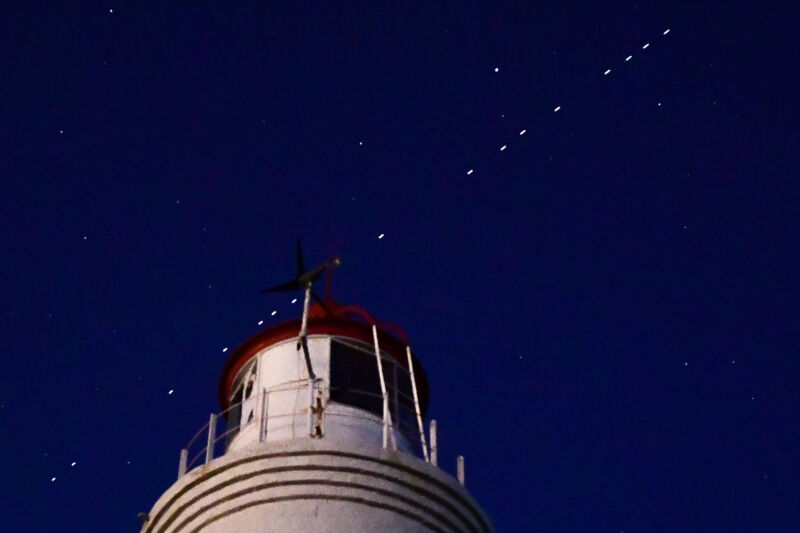NASA objects to new megaconstellation, citing risk of “catastrophic collison”
"This particular region of space tends to produce a large number of conjunctions."

NASA has formally commented (PDF) on a request by a US company to build a megaconstellation of satellites at an altitude of 720km above the Earth's surface, citing concerns about collisions. This appears to be the first time that NASA has publicly commented on such an application for market access, which is pending before the Federal Communications Commission.
"NASA submits this letter during the public comment period for the purpose of providing a better understanding of NASA's concerns with respect to its assets on-orbit, to further mitigate the risks of collisions for the mutual benefit of all involved," wrote Samantha Fonder, an engineer for the space agency.
At issue are plans put forth by AST & Science, which intends to build a constellation of more than 240 large satellites, essentially deploying "cell towers" in space to provide 4G and possibly 5G broadband connection directly to cell phones on Earth. The company, based in Midland, Texas, calls its constellation "SpaceMobile" and has raised an estimated $120 million.
The space agency felt compelled to comment on AST's proposal for several reasons. Most notably, the proposed altitude for the SpaceMobile constellation lies near the "A-Train," a group of 10 Earth-science monitoring satellites operated by NASA and the US Geological Survey, as well as partners in France and Japan. "Historical experience with the A-Train constellation has shown that this particular region of space tends to produce a large number of conjunctions between space objects," the NASA letter states.
They’re big, too
The satellites are also very large. In order to provide service, AST plans to build spacecraft with large phased array antennae—900 square meters. According to NASA, in planning for potential conjunctions with other satellites and debris in this orbit, this would require proscribing a "hard-body radius" of 30 meters, or as much as 10 times larger than other satellites.
Maneuvering around the proposed SpaceMobile constellation would be extraordinarily taxing, NASA said. "For the completed constellation of 243 satellites, one can expect 1,500 mitigation actions per year and perhaps 15,000 planning activities," the space agency stated. "This would equate to four maneuvers and 40 active planning activities on any given day."
Finally, the space agency is concerned because AST has never built a satellite remotely close in size to the 1-ton or larger vehicles that will populate its constellation. Given this lack of experience, it is expected that 10 percent or more of the satellites may fail, making them unable to maneuver to avoid collisions. NASA found the risk of a catastrophic collision to be "unacceptably high."
NASA submitted its comment on October 30, and the comment period closed Monday. Most of the other comments on the AST application were supportive.
In response to a query from Ars about NASA's submission, AST said it would work with NASA to ameliorate its concerns. “We have reviewed NASA's letter and are confident that we can work with them to address their concerns, including providing clarification of AST’s constellation design that robustly manages orbital debris, keeping NASA and other orbital assets safe," said Raymond Sedwick, Chief Scientist for Space Systems at AST.
What the FCC?
So why is this issue before the Federal Communications Commission? The responsibility for US space activities is scattered across several federal agencies, but the FCC manages spectrum. In this case, AST has already obtained a license to use spectrum in the V-band from Papua New Guinea (yes, that is legal). But to access the US market and sell its services, AST must still obtain permission from the FCC.
When it comes to megaconstellations—including SpaceX's Starlink, OneWeb, and others—the FCC has been considering the debris issue when it comes to putting hundreds, if not thousands, of new satellites into low Earth orbit. Therefore, it will be interesting to see in which direction the FCC goes on this issue because the federal agency has two competing interests.
In general, the FCC has been incredibly permissive when it comes to issuing spectrum licenses to satellite operators. "I'm not aware of any example of the FCC denying such a license," said Brian Weeden, a satellite expert at the Secure World Foundation. "They're trying to be business friendly and encourage companies to be doing business in the US."
However, the FCC has been using its spectrum authority to consider rules that would mitigate debris by requiring satellite operators to indemnify the government from potential accidents as well as have more maneuvering capability on their vehicles. A comment period for these proposed rules, which were first published in April, closed last month. It is not clear what the final rules will look like, but satellite operators have characterized some of the ideas as too onerous .
Finally, it is unclear how the FCC will handle the concerns of NASA, which knows a thing or two about space and is speaking up for the first time.
In the big picture, Weeden said, this dustup between NASA and AST is more evidence that the US government—and other spacefaring nations around the world—need to do a better job ensuring that low Earth orbit remains as debris-free as possible. There is no governmental agency specifically charged with ensuring low Earth orbit remains safe, and the existing models are failing to fully capture the threat from new and old satellites, spent rocket second stages, and known debris. So in some sense, with all the megaconstellations flying into space today, regulators are flying blind, he said.
"We should have done a lot of this work over the last 10 years," he said. "From a government policy oversight perspective, we're behind the power curve."
Via PaApNews